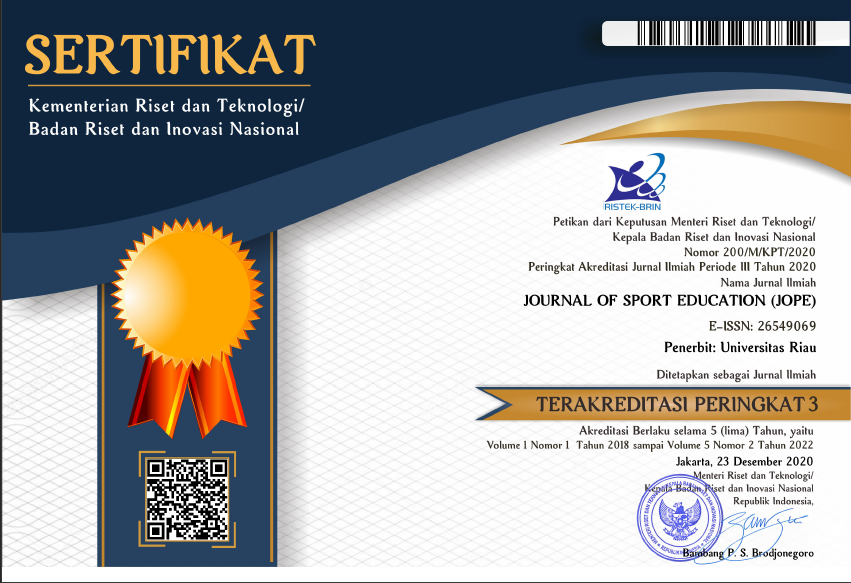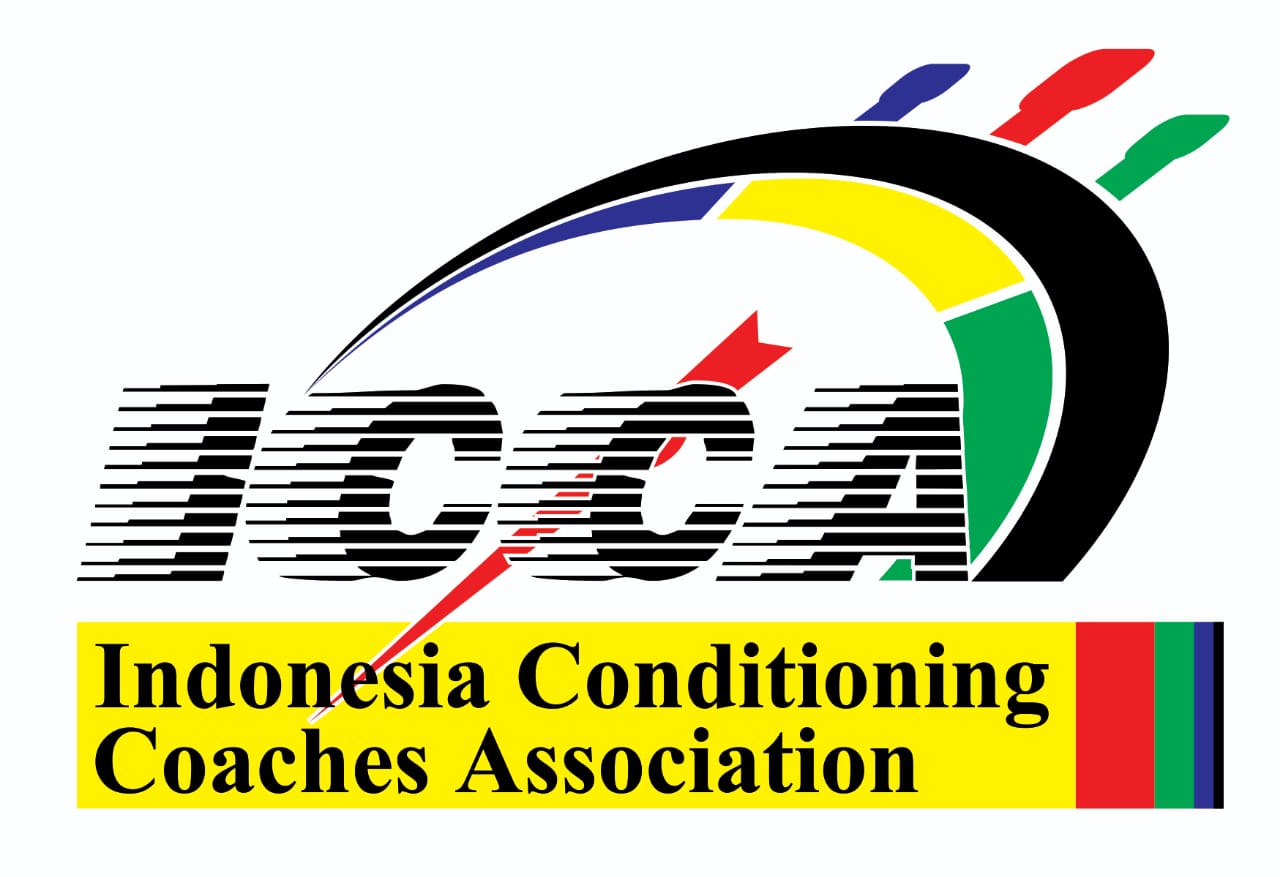Author Guidelines
The manuscripts
The manuscript should be an original research paper which sufficiently contributes novelty to sport education. Authors are requested to submit their papers electronically by using the Journal of Sport Education (JOPE) online submission procedure. The corresponding author should also provide a statement that the manuscript is not concurrently being under consideration for publication elsewhere. The Editors will ignore submissions that do not follow these procedures.
Structure of the manuscripts
1. Title. The title should be clear and informative, and not more than 14 words.
2. Author's names and institutions. The author's names should be accompanied by the author's institutions and email addresses, without any academic title. For a joint paper, one of the authors should be notified as the corresponding author.
3. Abstract and keywords. The abstract should be less than 200 words. Abstract consist of aims, methods, and result. Please provide the abstract in both English and Indonesian versions. The keywords should be of 3 to 5 words or phrases.
4. Introduction. This section explains the background of the study, a review of the previous researches in the area, and aims of the manuscripts. Importantly it should also show the significance and novelty of the research.
5. Methods. This section describes the appropriate tools of analysis along with the data and their sources.
6. Results. The results chapter only writes the results of the research which contains the data obtained in the study or the results of field observations along with the interpretation of data analysis. This section is described without providing a discussion, write it in logical sentences. Results can be in the form of tables, text, or images. The mention of a picture or table should precede the picture or table presented
7. Discussion. Discussion is the most important part of the overall content of scientific articles. The purpose of the discussion is to answer the research problem or show how the research objectives were achieved and interpret/analyze the results. Start by presenting the findings. Then relate it to previous theories and research, whether the findings strengthen or correct existing findings/theories. Emphasize new and important aspects. Discuss what is written in the results but do not repeat the results. Include a discussion of the impact of the research and its limitations.
8. Conclusion. This section concludes and provides policy implications, if any, of the study. The conclusion(s) should be at the same order with ones discussed in the body of the manuscript.
9. References. This section lists only the papers, books, or other types of publications referred to in the body of the manuscript.
General Writing Format
1. The manuscript is prepared in an A4 paper, double-sided, and single line spacing format. Using 12-size and Cambria font type.
2. The manuscript is written in Indonesian or English.
3. The manuscript should be between 8 to 15 pages long.
4. The top and bottom margins are 2 cm, and the left and right are 2 cm.
5. The title is written using capital letters only at first word or special name (example: location name), 12 font size, center position. The title are written using UPPERCASE BOLD
6. Subtitles are written using UPPERCASE BOLD style, 12 font size, starting from the left margin.
7. Sub of subtitles, if any, are written using capital letters only at first word or special name. They should be started from the left margin.
8. Sub of the sub of subtitles, if any, are written using capital letters only at the beginning of each word except for connecting words, all in italics. They should be started from the left margin.
9. References should be those of the last ten years publication (>80%), except for key references (80%). Referring to any textbook should be minimized (<20%).
Specific Writing Format
1. Equations and formula should be numbered as (1), (2)...etc appearing to their right.
2. Estimation results from a software package are not allowed to be directly presented in the paper. They should be presented in summary tables.
Tables and Figures
Tables and figures should be presented as follows:
1. The name of tables and figures should follow a numbering system (Arabic numbering system). The title of the tables and figures are placed at the top and the bottom respectively.
2. The tables and figures should provide the source of information, if any, at the bottom.
3. Any table should contain only heading and contents. The table contains row lines only without column lines. Note(s) and source(s) should be included underneath the table where appropriate.
Acknowledgment
Acknowledgment, if any, should be written as the foot-note of the manuscript's title.
Subjects and Authors Index
The authors should provide an index of subject, namely the specific terms in the manuscript. The authors should also provide the index of authors, namely the key authors of papers referred in the manuscript. Please write the family name followed by the given name.
Citation
Citation in the text body should be written using the family name and years of publication. Example:
a. Hill (2001) suggests that the objective of depreciation is ...
b. Inflation targeting would be sufficient (McCain, 1982).
c. The definition of contagion is ... (Wagner, 1976; Rhonda 2009).
d. The Authors are recommended to use Mendeley Reference software.
References
The manuscript is expected to involve approximately 20-25 primary and up-to-date references to assert high quality contributions to the knowledge development. Citations and references must strictly follow the APA (American Psychological Association) style. References should include only works that are cited within the text of the manuscript. Consulting the APA style manual (http://www.apastyle.org/pubmanual.html) is strongly recommended for completing manuscript submissions.
Manuscript Template
Manuscript should be prepared according to the following MS Word template:

How to send the manuscript
1. The manuscript in microsoft word should be sent to the editor by clicking Online Submission tab on our Website.
2. A brief bio that contains full name, academic title, institution, telephone, mobile number, and others should be written in the fields of data when registering online in the website submission.
Final Decision
Taking into account the results of the peer reviewing process, the decision as to the acceptability of each manuscript for publication will be notified to the author(s) through the website system in the following alternative conclusions:
a. Accepted
b. Revision
c. Rejected













